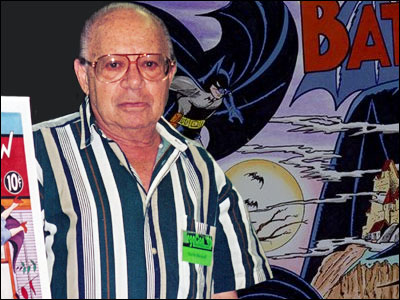Here's the third part of this essay. If you haven't read Part One yet, then you probably haven't read Part Two yet. Might be a good idea before you proceed…
In the early sixties, sales on Batman and Detective Comics (which of course featured Batman) were falling. Some histories say both titles were on the verge of cancellation but the folks I talked to about this — folks who worked for DC back then — said it hadn't quite reached that stage yet…but why wait until it did? DC's other super-hero comics, some of them rather new, were in ascendance. Why were the Caped Crusader's numbers heading in the wrong direction?
As I mentioned in the last part, I think the stories had gotten very silly and lost the essence of the character. And I think the artwork was too cartoony by the standards of the day. Changing the stories was just a matter of deciding to change the stories; to not have Batman and Robin flying off to other planets or battling monsters. Changing the artwork was a little more of a problem. Bob Kane still had that contract that called for the bulk of the Batman art to be at least penciled by his "studio."
The folks at DC thought the "studio" was Bob Kane plus a team of assistants. In truth, the "studio" was a man named Sheldon Moldoff who worked for DC, mainly as an inker, when he wasn't ghosting for Kane. In fact, Moldoff had been drawing for DC Comics before there was a DC Comics. He worked for all the companies — two or three, depending on how you count — that merged to form the famous company. He had a page in Action Comics #1. He drew the first covers featuring the Golden-Age Flash and Green Lantern.

"Shelly," as he sometimes signed the work of his that he signed at all, worked briefly with Bob Kane in the earliest months of Batman, then left to pursue his own career. In 1953, he became Kane's primary ghost artist…a position that was a mixed blessing. The money was okay but just barely…and of course, there was no credit. There was also the matter of dealing with Kane, who could be very difficult. Decades later, Shelly would be sitting on panels at comic book conventions, moderated by me and others, with Jerry Robinson, Lew Schwartz, Jim Mooney, Dick Sprang and others who drew stories bearing Kane's signature…and they'd be talking about what a cheap pain-in-the-butt Bob Kane could be.
Then again, the position kept Moldoff fully employed during some rough years when even some of the best artists in comics couldn't get enough work and had to scramble to earn wages in other fields. So it was not without its advantages. He also worked on some of Kane's non-Batman, non-DC ventures, like a cartoon show Kane was involved with, Courageous Cat and Minute Mouse.
One artist ghosting for another was not uncommon nor was it automatically assumed the ghost was being wronged. Quite a few of the top newspaper strips were not the work of the guy who got the credit. For over twenty years, not one bit of the popular Mutt & Jeff strip was written or drawn by Bud Fisher, the guy who'd created it, the guy whose name was on it. He'd turned the job over to a cartoonist named Al Smith. Ham Fisher (no relation) only wrote or drew the strip that he allegedly wrote and drew, Joe Palooka, when one ghost quit and it took him a while to find another.
And Shelly did do work as himself, mainly inking for DC. Sometimes, they had him ink "Bob Kane" pencils that he'd drawn…which raised the interesting question, "Didn't the DC editors know?" Moldoff said they didn't…or if they did, they didn't say anything. I asked others who were around then and got answers ranging from "Everyone knew" to "No one had any idea."
The answer I got that seemed the most convincing to me came from DC editor George Kashdan. He said, "No one thought Kane did it all or even most of it. But Kane had this contract and it was easier to just do 'Don't ask, don't tell.' As long as the pages came in on time, which they almost always did, no one cared. I guess we figured Shelly was doing some of it and weren't shocked to hear he was doing all of it." (It has been my observation that a number of editors working in comics over the years had much less ability to recognize the styles of artists they hired than did some of us readers.)
It became an issue in 1963 when DC started talking about changing the look and feel of their Batman comics. How do you change the art when there's a contract that says you can't change the artist? We'll discuss what they did in the next chapter.